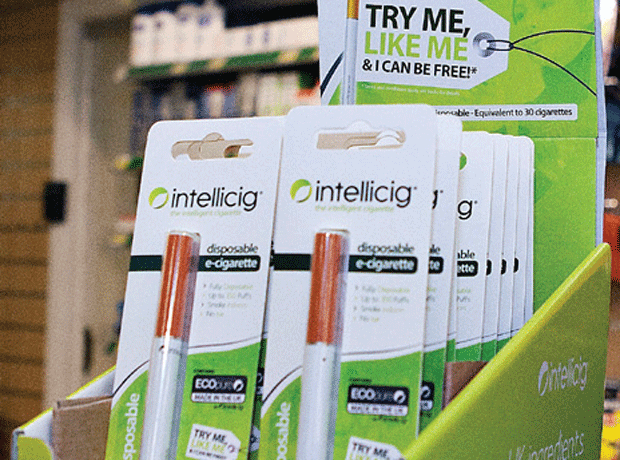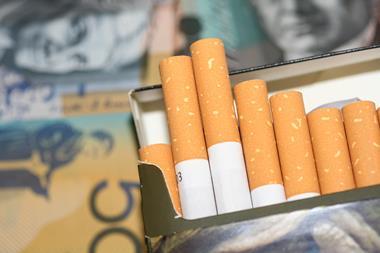Cigarettes are resilient. Despite critics constantly highlighting their drawbacks - like the fact they kill - one in three adults still sparks up every day, according to the World Health Organisation.
However, they may have finally met their nemesis, a nicotine-infused doppelgänger with the potential to be as fatal for cigarettes as cigarettes have been for humans. It’s the electronic cigarette, or the ‘e-cig’, for short. And it’s got the tobacco industry twitching like a smoker on a plane.
And no wonder. The e-cig appears to have endless advantages over the old-fashioned fag. With an e-cig or vaporiser (left), smokers get the nicotine hit and the smoking sensation they crave, but without the lethal levels of toxic substances in a real cigarette (the chemicals in e-cigs are lower level, claim experts - see over). E-cigs are also much healthier for the wallet than heavily taxed tobacco, more socially acceptable and less legally constrained, which means no more shivering outside offices, pubs and restaurants - on paper at least.
E-cigs versus tobacco in numbers:
7,000
“Dangerous chemicals” can be found in tobacco, according to Dr Neil Grunberg
16bn
Cigarettes are produced every day to satisfy 1 billion smokers
12m
People smoke in the UK
390,000
Fewer people will switch to e-cigs if regulated as medicines, says E-Lites
£2.5bn
The amount smoking-related diseases costs the NHS to treat
95%
The failure rate of nicotine replacement therapy (patches, gums), according to ECITA
5bn
Lives would be saved, if everyone switched to e-cigs, claims Professor John Britton
3%
The annual fall in smokers globally
91%
Of smokers say e-cigs “substantially decreased” tobacco cravings
2.7%
The amount of tobacco market share e-cigs are forecast to steal by 2015, according to Nielsen
The upshot? The market is booming. With 1.5 million users in the UK alone, Nielsen predicts sales will triple by the end of 2015 to £338m. E-cigs seem as unstoppable as the death of the traditional cigarette seems inevitable. But what’s prompted their meteoric rise and are we really witnessing the last gasp of the traditional tobacco industry - or is it too soon to embrace the notion that there can be smoke without fire?
E-cigs may have been something of an overnight success story, but their roots are half a century old. The concept dates back to 1963, when a patent was filed by Herbert A Gilbert for a “safe and harmless means of smoking by replacing burning tobacco and paper with heated, moist, flavoured air”. Sadly for Gilbert, the patentlapsed in 1967 without making it into production.
Forty years later another patent appeared courtesy of Hon Lik, a Chinese 60-a-day man who quit the tabs after his equally heavy smoking father died from lung cancer. His patent went into production and was launched in China in 2004 by Golden Dragon Holdings, now Dragonite International.
It wasn’t until 2007 that e-cigs started to trickle into the UK, riding in on the coat-tails of the indoor smoking ban. And while tobacco cowers shamefully behind shutters in supermarkets, e-cigs are now in your face, loud and proud on every counter - even making a memorable cameo in the controversial video for Lily Allen’s comeback single Hard Out Here.
As demand has exploded, so has the number of manufacturers eager to jump on the bandwagon. “The popularity of e-cigs is growing at an astonishing rate,” says Adrian Everett, CEO of E-Lites, which was founded in 2009 and is now the largest e-cig company in the UK. Everett says usage has “doubled each year for the last three years and will only increase. We stocked 200 retailers 18 months ago. Today we do over 20,000.”
Retailers are also reaping the rewards. Tobacco returns a margin of around 8% whereas e-cigs return up to 45%. “That’s a big difference,” says Everett. “Plus the retailer suddenly has incremental revenue channels like chargers and batteries, so it’s a much higher-margin product with additional products they can sell to an established customer.”
Without the duty incurred on tobacco products, e-cigs are not only higher margin for retailers, they’re also significantly cheaper for consumers - the straitened economic climate providing another boon for the category. “We have found the main reason people switch to e-cigs is for the financial benefits,” says Freshcig MD Ben Wilson, which launched its first e-cig product in 2011. “E-cigs offer savings of over 75% compared with the real thing and during harder times this has been a main driver for growth.”
What the science says…
So what’s in an e-cig?

Propylene glycol: A major ingredient, this is a clear, colourless and water-absorbing liquid. It is non-corrosive, has low volatility and is non-toxic.
Ethanol: Aka alcohol. One of the oldest recreational drugs known, and produces a state known as ‘alcohol intoxication’ when consumed as a beverage.
Glycerol: Sweet-tasting and of low toxicity, it is a colourless, odourless and viscous liquid that is widely used in pharmaceutical formulations.
Nicotine: An e-cig can contain as much as a regular cigarette, or more. The amount delivered depends on the contents of the liquid-nicotine cartridge.
It’s not all good news, however. A major selling point for e-cigs is that, in theory, they can be enjoyed indoors. In practice, that isn’t always the case. Pub chain Wetherspoon has banned them and other restaurant chains are doing the same. They’re not permitted by a number of train operators and planes have banned them outright.
Everett concedes that airlines have good reason to ban e-cigs, but says public places should allow them. “The O2 is one of the world’s most respected venues and we’ve recently replaced their no smoking signs with ‘No Smoking - E-cigs permitted’. That kind of process will ultimately lead to greater understanding and acceptance, but it’s slowed down by de-contextualised and completely wrong negative press.
“It doesn’t take a great deal of negativity to cause public concern. There is no legitimate health reason why vaping should not be embraced by all establishments. And to force someone using an e-cig outside to stand with smokers puts you on rocky legal ground. One of the reasons for the smoking ban was to protect people from passive smoking. If you insist they stand with people who are smoking you reverse that process.”
Non-smokers have nothing to fear from proximity to e-cigs, adds Douglas Mutter, operations manager for SkyCig. “In our own offices, e-cigarette users vape their e-cigs next to non-smokers and it doesn’t cause any harm or discomfort. If it did then we would not allow it. We see no reason why the same shouldn’t be the case on trains, planes and in other public places.”
Convincing pubs is one thing, convincing the government quite another. The government’s medicines watchdog, the Medicines and Healthcare Products Regulatory Agency (MHRA), wants to regulate e-cigs as medicines by 2016. If regulated as such, all existing products would have to be withdrawn from sale immediately until approved by the MHRA for sale.
This July, the MHRA revealed the conclusions of its e-cig consultation and testing. It claimed nicotine varied “considerably” from on-pack information and differed “wildly” from batch to batch. “Toxic elements may be included at unexpectedly high doses, which could produce adverse effects,” it added.

As for whether they could be classified as medicinces, it argued: “Most use is to support stop smoking attempts. This is comparable to other nicotine replacement therapy products, which are licensed as medicines.” Therefore, e-cigs should be regulated as medicines to “manage the risk of poor and ineffective products and to maximise the potential for public health gain”.
Medicinal or not?
It is not a stance that has resonated on the European stage. On 8 October, MEPs voted against medicinal regulation of e-cigs in the draft Tobacco Products Directive by 362 votes to 298. However, back in the UK, in the House of Commons on October 24, under-secretary of state for public health Jane Ellison said the government was prepared to go it alone - much to the irritation of some in the e-cig community.
“We’re keeping the champagne on ice,” says Everett, soberly. “There was an outbreak of common sense in Brussels and we applaud the MEPs who stood up against the bureaucrats who were using scare tactics to force through the wrong regulatory solution, but there is a long way to go.”
Opponents to such regulation stress they are not trying to duck regulation per se. Electronic Cigarette Industry Trade Association (ECITA) president Katherine Devlin says proper regulation of e-cigs is “vitally important”. She adds: “Consumer protection is paramount. Nicotine liquid is inhaled into the lungs so there can be no contamination and the ingredients must be accurate.”
However, she despairs at the official government stance. “Medicinal regulation is fundamentally the wrong fit for e-cigs,” she believes. “The MHRA sound like an isolated voice in the wilderness bleating ‘medicines… medicines…’ when it’s just not a viable option.”
Independent experts agree. Clive Bates, a former director of Action on Smoking and Health, and Gerry Stimson, who has advised the government and the WHO on tobacco, released a report in September saying: “Medicines are sold for their therapeutic qualities, e-cigarettes for their appeal as consumer products. This is a fundamental difference. The effect of the regulations is to ban e-cigs not licensed as medicines. In doing so, it requires a product that is not a medicine to seek approval as a medicine. It is easy for the layman to see the legal vulnerability in this.”
As for concerns over varying levels of nicotine, Bates and Stimson argue: “Such precision is unnecessary for e-cigs as users control the dose they take by how they draw on vapour, varying depth and frequency of puffs to achieve a satisfactory experience. Whilst absolutely consistent performance might be desirable it is not necessary, and without elaborate control electronics built into the product design, it is not achievable.”
Bates and Stimson also warn that medicinal regulation could benefit the tobacco industry. “If classed as medicines, e-cigs would only be available in pharmacies. Medicinal regulation would also impose expenses, burdens or restrictions that are high, unnecessary and not imposed on the cigarette industry.”
Advertising restrictions

Even the biggest fan of e-cigs is unlikely to want to see children wandering around sucking on them, yet there is no legal age limit in place to restrict the sale of e-cigs to minors.
The vast majority of suppliers have printed age limits on packs anyway, but the ASA recently swung into action over concerns that existing ads could appeal to kids. It subsequently banned four ads including an E-Lites TV ad that featured a dancing baby (above), which it felt could appeal to children.
The problem for e-cigs is that ASA rule 10.4 states: “If it shares a name, emblem or other feature with a tobacco product, a non-tobacco product or service may be advertised only if the advertisement is directly targeted at an adult audience, makes or implies no reference to smoking or to a tobacco product, does not promote tobacco or smoking and does not include a design, colour, imagery, logo style or the like that might be associated in the audience’s mind with a tobacco product.”
An ASA spokesman says that means advertising e-cigs is “severely restricted, so the kinds of claims and images that can be used to promote them is incredibly limited”.
E-Lites, however, insists it was not trying to get around ASA legislation by agreeing to appear in the video for Lily Allen’s latest single. “The record company approached us to be involved,” says a spokesman. “After we were comfortable this was aimed at an over 18s audience, we were delighted to be a part of it.
“We do not see this as an alternative to other advertising and are working closely with the ASA and CAP to help frame a set of realistic advertising guidelines which enable our industry to communicate properly.”
This applies equally to print. The ASA spokesman advises: “Marketers should avoid claiming smoking e-cigs is healthier than smoking tobacco, or risk free, unless they have robust clinical evidence to support their claims.”
Finally, the Committee of Advertising Practice has announced it is proposing new rules for e-cig advertising and will launch a consultation in the new year.
To add to the drama, not all e-cig manufacturers are anti-medicinal regulation. Nicolites, another leading brand in the UK, believes the “framework the MHRA are imposing will give even further confidence to consumers” when it comes to the safety of e-cigs.
“We are 100% certain Nicolites will gain the necessary licence before 2016,” adds MD Nikhil Nathwani. “We began the process some time ago and we are a long way down the road to complying.”
Unsurprisingly, the tobacco industry is not opposed to the idea of e-cigs being regulated as medicines either. Devlin believes that ‘big tobacco’ is actively lobbying the government for regulation because, even though it is launching e-cigs of its own, it can afford to pay the associated costs while fledgling e-cig companies can’t.
“Big tobacco is being schizophrenic. They are buying in like mad, but also trying to get the regulatory bar set so high only they can afford to do it. They want e-cigs to be regulated as medicines so they can wipe out the competition. They can afford to jump through all the hoops and they don’t care how rubbish the product ends up being. It’s fine by them because it keeps everyone smoking, doesn’t it?”
“Tobacco companies know how big e-cigs will become. They want to make money and they want to get everyone else out of the game”
Anthony Armstrong
Anthony Armstrong, who sold Zig-Zag in 2010 to move into e-cigs as well as vapourisers and liquid nicotine, which he predicts will supersede standard e-cigs, is similarly critical. “The government banged on for years about cutting down tobacco, but as soon as something comes out that could replace it, it jumps on the anti-bandwagon.
“Establishing why depends how cynical you want to be, but there is a huge amount of money involved. Tobacco companies know how big e-cigs will become. They want to make money and they want to get everyone else out of the game.”
A spokesman for the MHRA rubbishes suggestions e-cigs would only be available in pharmacies if regulated as medicines. “As with all forms of nicotine-containing products, they would be available in the corner shop,” he says, defending the MHRA’s role in regulation of e-cigs. “The government’s position is that reducing the harms of smoking can best be achieved by the regulation of e-cigs under the medicines framework.”
He also insists the MHRA was not put under pressure by tobacco. “We were not lobbied by the tobacco industry, although some will have responded to the consultation,” he says.
Imperial Tobacco is among those that responded. “We’re actively engaging with regulators to support the development of appropriate regulatory frameworks,” confirms a spokeswoman. However, while it supports medicinal regulation, she is quick to stress it should only apply to e-cigs that make smoking cessation claims. “All other types of e-vapour products should fall under an independent uniform regulatory framework.”
A BAT spokesman, meanwhile, says it is “encouraging the government to regulate e-cigarettes in a way that ensures consumer safety and product quality as well as the appropriate level of innovation, marketing and distribution freedoms required to enable this important category to grow”.
The e-cig opportunity
Calls for regulation have not stopped tobacco companies from entering the e-cig fray themselves (if entirely cynically as far as some are concerned).
E-cigs present a real “opportunity”, claims JTI UK MD Jorge da Motta. “It is a focus for non-tobacco and tobacco companies and certainly one that we have,” he says. “We have a number of initiatives we are working on and it is much bigger than just e-cigs.”
BAT adopts a similar line. “Many smokers are showing interest in these types of products and, for some of those smokers, e-cigs are offering them a viable alternative to their usual cigarettes. It is strategic to keep our eye on the future by developing a range of products that can offer reduced-risk alternatives.”
“Big tobacco wants e-cigs to be regulated as medicines so they can wipe out the competition”
ECITA president Katherine Devlin
Indeed, BAT’s e-subsidiary Nicoventures has just launched its Vype e-cigs into a host of retailers, including the major multiples, and has thrown £3.6m at marketing to support it. This is dwarfed by what Imperial is up to, however. In October, it shelled out £47m for Dragonite International’s intellectual property.
A spokeswoman confirms the deal includes a “number of patents relating to e-cig technology, giving us important knowhow in the sector developed by a pioneer (Hon Lik) of e-cigs”. She adds that Imperial “will be going to market” with a product in 2014.
Like BAT, JTI and Imperial, other tobacco companies, including Philip Morris, Altria and Lorrilard, are developing e-cigs because they have to. Customers are switching and tobacco wants them back, because despite statistics showing e-cigs perform well as a cessation aid, not everyone is switching to quit.
In fact, e-cig companies are starting to play down that effectiveness because it aligns them with medically regulated NRT, which strengthens the case for medicinal regulation. So the new industry mantra is that swapping is a healthier lifestyle choice. And there is no question that e-cigs are healthier.
“Moving from combusted tobacco to heated nicotine liquid removes over 99% of potential health risk,” says Everett. “E-cigs don’t kill you, but with tobacco the chance is one in two.”
“E-cigs are probably much less dangerous than smoking tobacco, but e-cigs should only be sold to people already addicted to nicotine”
Dr Joseph DiFranza
Devlin adds that e-cigs are “a way for adults to find a way out of smoking tobacco. It’s just better than smoking, like switching from full fat cola to diet cola.”
Even BAT admits that e-cigs are a “less risky” option than cigarettes. “It is largely the toxicants found in cigarette smoke that cause the majority of smoking-related diseases, not the nicotine itself,” says a spokesman.
However, nicotine experts point out that although e-cigs are healthier than cigarettes, that doesn’t make them healthy.
“Nicotine may contribute to cardiovascular disease, although that is not clear,” says Dr Joseph DiFranza, who has been researching the effects of tobacco since 1980. “E-cigs are probably much less dangerous than smoking tobacco, but e-cigs should only be sold to people already addicted to nicotine. The only therapeutic use of nicotine is to treat nicotine addiction.”
Dr Neal Grunberg is equally circumspect. “Nicotine can have positive effects, such as enhanced selective and sustained attention and decreased distraction. It also helps to control appetite and body weight.”
But he warns more research is needed into e-cigs. “We need more information about what is being inhaled and in what amounts. E-cigs offer an important advance to help smokers get away from the 7,000 dangerous chemicals inhaled when smoking, but nicotine is a highly addictive drug and, in high dosages, also poses physical health risks, including vasoconstriction and stimulation of the heart and effects on heart muscle.”
He is also concerned about the possibility that “ex-smokers will be drawn back to nicotine self-administration via e-cigarettes”.
However, he adds that while that is “not desirable, it is better than returning to tobacco”.
Herbert A Gilbert certainly thinks so. He’s in his 80s now, but the man who dreamed up the e-cig is still plugging away, pushing his brand of ‘1963’ e-cigs. In a blog on his company website, Gilbert says: “My wish was to have an alternative to the scourge of tobacco cigarettes. With the e-cig market starting to explode, more than ever my dream is rekindled to help save millions of lives every year from cancer caused by tobacco.”
David and Goliath
Dr DiFranza, however, suspects tobacco will have the final word. “Once the market position for these products, and more importantly, the regulatory position, is established, the tobacco industry will buy up the most successful e-cig manufacturers, or buy their patents,” he says.
Imperial’s deal with Hon Lik’s Dragonites is evidence it’s already started.
And ominously for any e-cig companies that have copied Lik’s original patents, Imperial says that as part of the deal, it has also snapped up some “ongoing legal claims, which we will be reviewing”.
Meaning, while e-cigs could yet evade medicinal regulation, a brand new battle against a familiar and resilient enemy could be about to begin.

Dr Ling Ge, DPhil (Oxon.) FRI MRSC, has conducted ground-breaking research in exotic materials at Imperial College London. Here she breaks down what’s in an e-cig, and whether or not they are harmful to users and those around them:
How does the amount of nicotine in an e-cig compare to the real thing? A 2009 analysis found that a Ruyan V8 e-cig delivered 10% of the nicotine, per puff, delivered by a regular Marlboro. In other words, a two-second puff of a Marlboro will deliver ten times the amount of nicotine as a two-second puff on a Ruyan V8.
One 2010 study by Nicotine and Tobacco Research found that placebo e-cigs with no nicotine relieved the desire to smoke within the first ten minutes of consumption.
Do e-cigs contain contaminants? A 2009 analysis by the FDA found e-cigs contained carcinogens and toxic chemicals, like diethylene glycol and ethylene glycol, as well as nitrosamines. Diethylene glycol and ethylene glycol are also used in antifreeze.
Is there risk from the second-hand vapour? A 2012 study published in Inhalation Toxicology compared pollutant concentrations between e-cigs vapour and tobacco samples.
Pollutants found included volatile organic compounds, carbonyls, polycyclic aromatic hydrocarbons, nicotine, TSNAs, and glycols. And for all byproducts measured, e-cigs generated far smaller exposure relative to tobacco cigarettes. The study indicates no apparent risk to human health from e-cig emissions.
A technical report by Igor Burstyn, published this August, lists volatile organic compounds in the aerosols generated by e-cigs including toxic substances and carcinogens like acetaldehyde, acrolein, crotonaldehyde, and formaldehyde.
However, the concentration is so low he concluded the chemicals pose no health concern for users or bystanders.















No comments yet